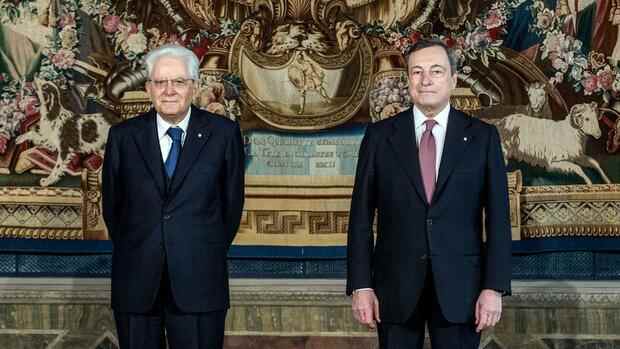In mid-February 2021, Draghi formed a new government at Mattarella’s request.
(Photo: imago images/Insidefoto)
Rome When you order a second helping in an Italian restaurant, it means “until”. On Saturday evening, after six tough election days and now eight ballots, one thing is clear: Italy will get “Mattarella until”, as Sergio Mattarella’s second term is already called. The 80-year-old had already organized his move out of the Quirinal Palace and rented a new apartment in Rome. Again and again he ruled out hanging on for another seven years. Now he does it after all – probably out of a sense of duty, for fear of unstable conditions.
Italy has experienced political chaos in recent days. Again and again, blank ballot papers were handed in, entire factions abstained, and the names of professional football players or actors landed on the ballot papers in protest. The parties that currently form the government in a broad coalition could not agree on a candidate for the primarily representative office. Dozens of names circulated, but no one got the required majority. Not even Prime Minister Mario Draghi, who has been the favorite for the presidency for months.
Then, on Saturday, there was a surprising turn of events: in the morning, Draghi met Mattarella, as sources from political Rome confirm. There Draghi is said to have asked the president to run again: for the good of the country, for political stability. The parliamentary group leaders then met with Mattarella – and expressed their goodwill for the solution. At 8:22 p.m. in the evening, the time had finally come: Mattarella achieved the required quorum of 505 votes during the count in Parliament, the MPs stood up and applauded for several minutes.
Government crisis and new elections have been averted
This clears the next political question mark that Italy would have faced if Draghi had been elected president: who should have succeeded the former central banker as prime minister? There was even the justified fear that the broad coalition, which ranges from left and social democrats to liberals and right-wing populists, would then have collapsed. Italy would then have had a president who was respected both at home and abroad – but it might have been directly before early elections. A scenario that entrepreneurs and financial markets in particular had feared.
Top jobs of the day
Find the best jobs now and
be notified by email.
Mario Draghi had also expressed interest in the presidency before the elections. But then he appealed to the incumbent President to accept another term.
(Photo: Reuters)
Thanks to Mattarella’s concession, everything now remains the status quo: Draghi can continue to lead the government until the legislature ends in May 2023 at the latest. Then there are parliamentary elections. The only question is how strong Draghi’s mandate is now, whether he can continue to govern as he has been – or whether a long election campaign between the left and right poles in the government will soon begin, which could paralyze the coalition?
“After the summer, in September at the latest, we will enter the election campaign phase,” explained Giovanni Orsina from the Luiss University in Rome. It doesn’t matter who governs: In the primary election period it will be difficult to push through far-reaching reforms. But there is still a lot of time until then. And Draghi’s government, in which technocrats rather than politicians hold key positions, has shown in less than a year how serious the zeal for reform and the will to modernize the country in the long term.
Even though Mattarella never ran for a second term, the number of ballot papers with his name on them has continued to grow in recent days. On Monday, in the first ballot, the Sicilian got 16 votes, on Thursday there were already 166. There was only a slump on Friday morning: there the parties of the centre-right block tried to push through a candidate. But Maria Elisabetta Alberti Casellati, President of the Senate, failed. On Saturday morning, the votes for the new and old President soared to a new high: 387.
More: Italy’s President: Key role in government crises
